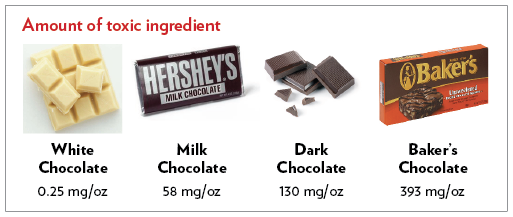
As a veterinarian, I get the most calls — by far — during the year-end holiday season (and Easter and Halloween) about chocolate ingestion by pets.
Chocolate can be very toxic to your dog, but the amount and the type of chocolate is critical in assessing whether or not you have to panic.
Below are some golden rules to place on your refrigerator while you’re waiting for your vet to call back.
With this information, maybe you don’t have to panic at all.
Rule #1: Know Your Pet’s Weight and How Much Chocolate Was Eaten
With any poisoning or toxicity question, know your pet’s approximate weight and the best guess as to how much of the toxin your pet may have eaten.
If you ever have to make a call to a pet poison hotline, it’s almost a waste of money if you don’t have a general idea of the amount of the offending substance:
- Try to round your dog’s weight to the nearest 10 pounds: 20, 50, 100 pounds, etc.
- Get the best idea of the most chocolate your dog could have eaten — three 16-ounce bags of peanut M&M’s, 4 ounces of dark chocolate, and so on.
Rule #2: What Kind of Chocolate?
The darker the chocolate, the more toxic:
- Baker’s chocolate is scary.
- White chocolate is almost nontoxic.
How Much Chocolate Is Toxic for Dogs?
- Baking chocolate: Approximately 0.5 ounce for a 10-pound dog, 1 ounce for a 20-pound dog, and 1.5 ounces for a 30-pound dog all require a call to the vet. Baking chocolate includes Baker’s Chocolate, Callebaut, Ghirardelli, Guittard, Lindt, Menier, Scharffen Berger and Valrhona.
- Dark chocolate: Approximately 1.5 ounces for a 10-pound dog, 3 ounces for a 20-pound dog, and 4.5 ounces for a 30-pound dog all require a call to the vet.
- Milk chocolate: Approximately 3.5 ounces (more than 2 regular Hershey’s Milk Chocolate Bars) for a 10-pound dog, 7 ounces for a 20-pound dog, and 10.5 ounces for a 30-pound dog all require a call to the vet. Milk chocolate includes M&M’s, Hershey’s, Mars, Kit Kat, Dove, Cadbury, Toblerone, Kinder, Ferrero Rocher and Galaxy. Semi-sweet chocolate has a similar toxicity.
- White chocolate: All but impossible for a dog to overdose on. Approximately 47 pounds of white chocolate for a 10-pound dog, 95 pounds of white chocolate for a 20-pound dog, and 145 pounds(!) of white chocolate for a 30-pound dog all would require a call to the vet.
The “Formula”
In case you’re wondering how we came up with the information above, there’s a formula.
If you’re mathematically inclined, you can follow the table below and get a good idea of the level of chocolate toxicity.
You have to know how to convert the chocolate into its toxic form.
If your dog ingests an amount CLOSE to 20 mg or more of toxic ingredient per pound of dog, you need to call the vet right away.

To illustrate the math, let’s say you have a 20-pound dog. We’ll call her Cookie.
- Example 1: Cookie (bad dog!) has eaten 3 ounces of dark chocolate. Dark chocolate contains 130 mg/oz of toxin, as shown in the chart above. So, 3 oz x 130 mg divided by 20 pounds of dog weight = 19.5. Is this a worrisome amount for Cookie? Yes, it’s very close to 20. YOU SHOULD CALL THE VET — or bring the pet to the emergency hospital. Remember, anything close to 20 or above is an emergency.
- Example 2: What if this was 3 ounces of milk chocolate? Let’s do the math: 3 oz x 58 mg divided by 20 pounds of dog weight = 8.7. You are not anywhere close to the toxic “magic number” of 20. You can relax.
Many of my clients panic when their dog eats a few M&M’s or some chocolate brownies. Neither of these products is solid chocolate, so the amount of chocolate ingested is much less and therefore less toxic.
The pet may still get an upset stomach or diarrhea, but you won’t have to worry about bringing them to the emergency hospital.

This Just in…
As I am writing this, an emergency call has come in.
“Those rotten ——-! They got under the tree, unwrapped the chocolate-covered cherries and ate 16 of them. What do I do?”
I ask her to tell me what her dogs weigh, and what is the total number of ounces in the chocolate-covered cherries box.
- Her dogs weighed 60 and 40 pounds.
- The box of cherries was 8 ounces.
You guys are pros now. You know how much chocolate is toxic for dogs — so does she have to worry? Not at all.
Why? Let’s suppose her smaller dog ate the entire box — worst-case scenario:
- That’s 8 ounces of candy, some of which is milk chocolate.
- Even if it was 8 ounces of pure milk chocolate, not counting the cherries and syrup, we’re not even close to a toxic ingestion.
- Here’s the math: 8 x 58 mg divided by 40 (smaller dog’s weight) is just 11.6.
And, again, this would be the worst-case scenario — which assumes little piglet dog didn’t share a single bite with big piglet dog.
She can relax, because 11.6 is not close to 20.
References
- Gwaltney-Brant, Sharon M., DVM, PhD, DABVT, DABT. “Chocolate.” Merck Veterinary Manual. https://www.merckvetmanual.com/toxicology/food-hazards/chocolate.
- Peterson, Michael E., DVM, and Patricia A. Talcott, MS, DVM, PhD, DABVT. Small Animal Toxicology. Elsevier Health Sciences. 2013. 648–651.
- Zoumas, B.L., Kreiser, W.R, and Martin, R.A. “Theobromine and caffeine content of chocolate products.” Journal of Food Science. 45:314, 1980.
 This pet health content was written by a veterinarian, Dr. Debora Lichtenberg, VMD. This article was originally published in 2012, and it has been reviewed for accuracy by Dr. Pippa Elliott, BVMS, MRCVS, and was last updated March 25, 2020.
This pet health content was written by a veterinarian, Dr. Debora Lichtenberg, VMD. This article was originally published in 2012, and it has been reviewed for accuracy by Dr. Pippa Elliott, BVMS, MRCVS, and was last updated March 25, 2020. 

